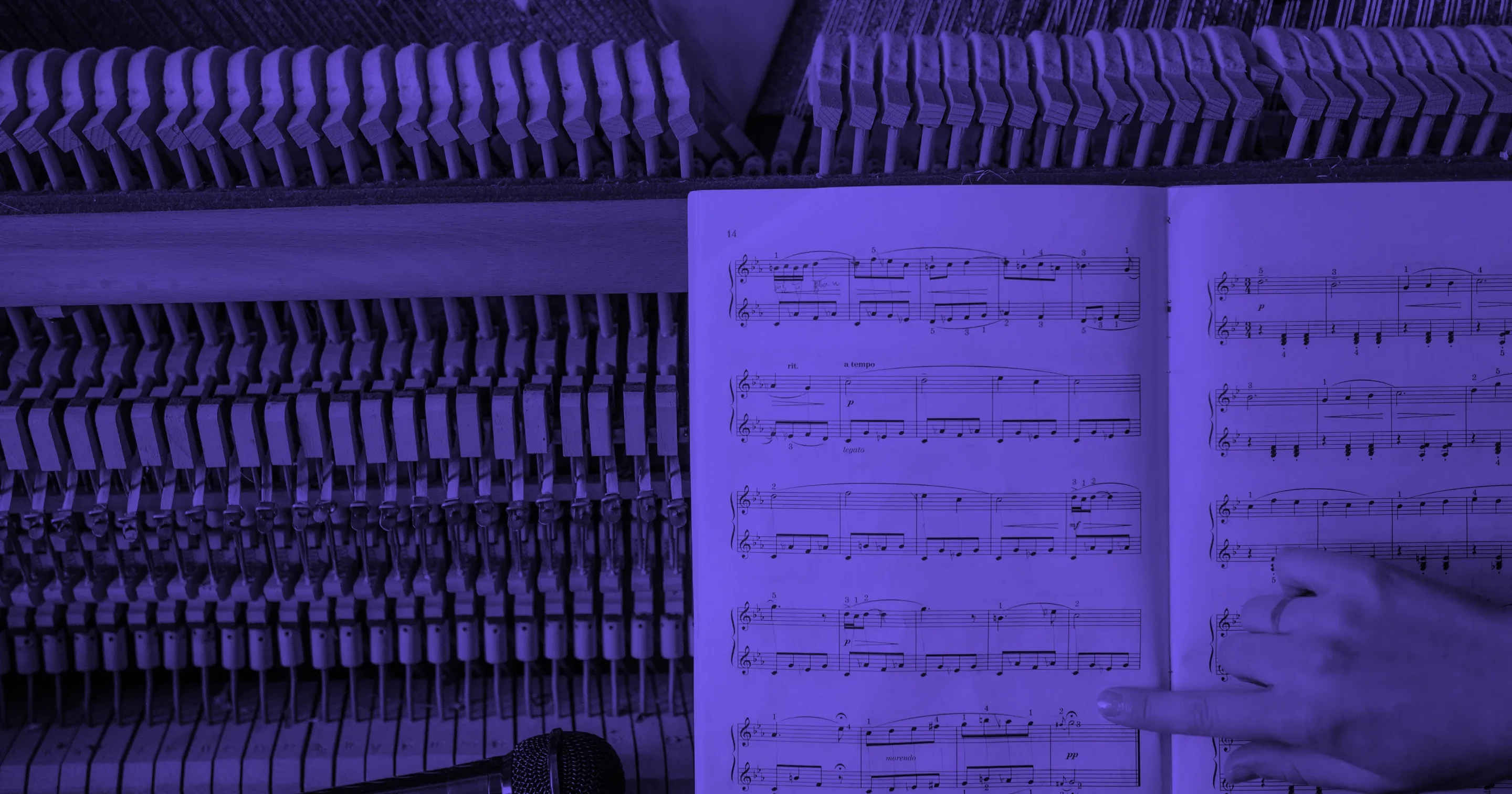
A Comprehensive Guide on Creating Seventh Chords in F Sharp Minor
Learn to build and use seventh chords in F Sharp Minor with this in-depth guide. Explore their harmonic functions, famous examples, and practical ways to enhance your music.
Introduction
Expand your musical palette by mastering seventh chords. These chords, created by adding a seventh interval to a triad, add richness and complexity to your harmonies. While often associated with jazz, they are a powerful tool in various genres, creating emotional depth and tension.
A solid grasp of music theory, particularly chord construction, is key to utilizing them effectively. This guide will teach you how to build all seventh chords in F sharp minor, explain their functions, and show you how they're used in popular music, empowering you to add harmonic sophistication to your playing and composition.
F Sharp Minor Scale and Chord Construction
This section details the connection between the notes in F sharp minor, their positions within the scale, and the resulting chord qualities.
- F# - Tonic (1st degree) - i
- G# - Supertonic (2nd degree) - ii°
- A - Mediant (3rd degree) - III
- B - Subdominant (4th degree) - iv
- C# - Dominant (5th degree) - v / V
- D - Submediant (6th degree) - VI
- E- Subtonic (7th degree) - VII

Chord building is fundamental to music theory. Notes within a key align with specific scale degrees, the building blocks of chords. Chords themselves are formed by layering major and minor thirds. A solid grasp of these intervals and their interactions is crucial for discerning chord qualities, particularly when delving into seventh chords and other types of chord extensions.
Here’s an explanation of the notes used to construct a seventh chord.
- The root note: It's the core, setting the chord's tonal foundation.
- The third: This interval dictates whether the chord is major or minor.
- The fifth: This interval adds further sonic character, and can be perfect, diminished, or augmented.
- The seventh: Adding this interval creates a seventh chord, expanding the harmonic complexity - the seventh can be major, minor, or dominant.
Simply, seventh chords are constructed by adding a seventh to a triad. The specific type of seventh chord depends on the combination of the triad type (major, minor, diminished, or augmented) and the type of seventh interval (major, minor, or diminished).
The diatonic seventh chords in F sharp minor are: F#m7, G#dim7, Amaj7, Bm7, C#m7, Dmaj7, E7.
Seventh chords possess distinct sonic qualities and harmonic roles. Next, we’ll analyze the diatonic seventh chords in F sharp minor, and then discuss their general characteristics and applications. For a more detailed exploration of F sharp minor key signature check out the article “Chords in F sharp minor: A Comprehensive Guide”.
Diatonic Seventh Chords in F Sharp Minor
i - F# minor 7
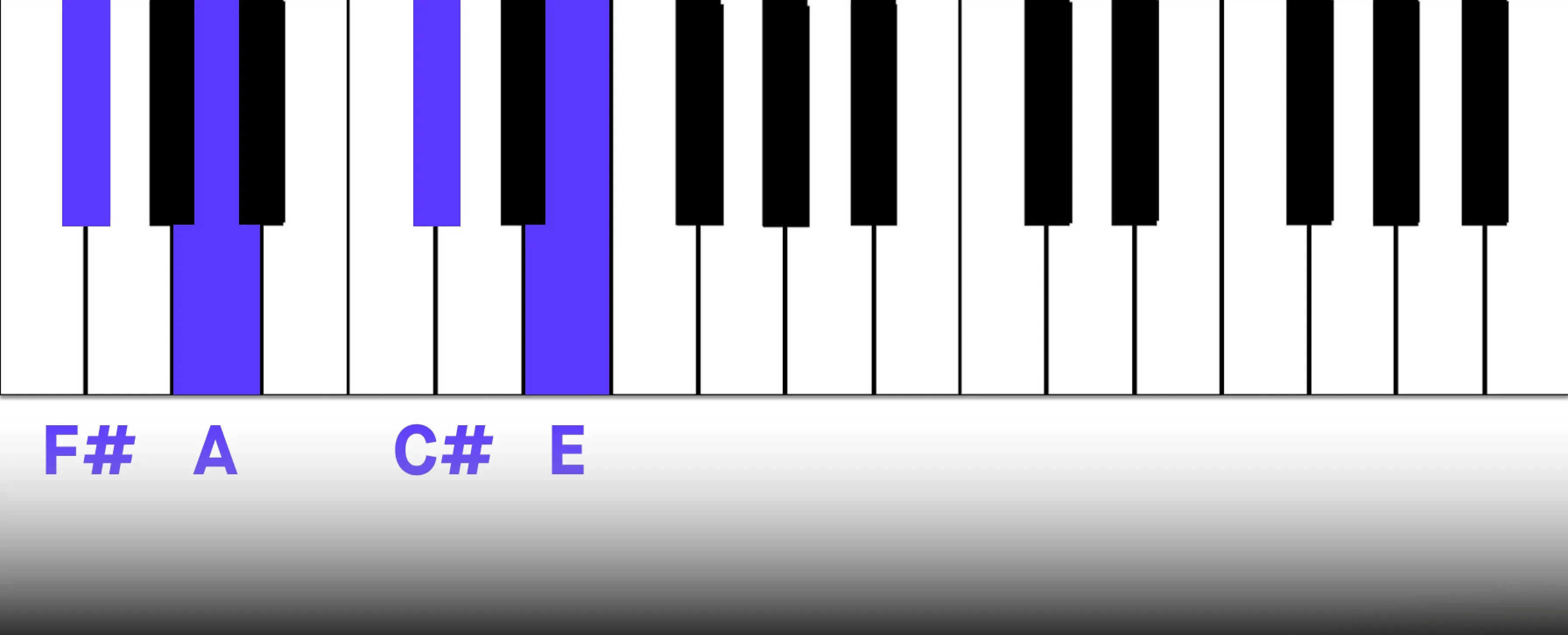
The F#m7, functioning as the tonal center, frequently grounds musical phrases, offering a sense of completion and resolution. The home chord is frequently the starting point for chord progressions in F sharp minor.
Unlike other chords that may bring about tension or instability, the F#m7 serves as a steady harmonic foundation, which defines the key's character. It offers a sense of stability, conveying both resolution and emotional depth, contributing to a feeling of finality.
The minor seventh interval added to the basic F sharp minor triad adds a layer of refined intricacy. This addition doesn't create noticeable tension or discord; rather, it enriches the chord's tonal color, adding a subtle warmth and resonance that heightens the emotional impact of the tonic.
Inverting F#m7 allows for a brief moment of harmonic instability, which is a valuable tool for creating nuanced progressions and preventing a predictable sense of resolution.
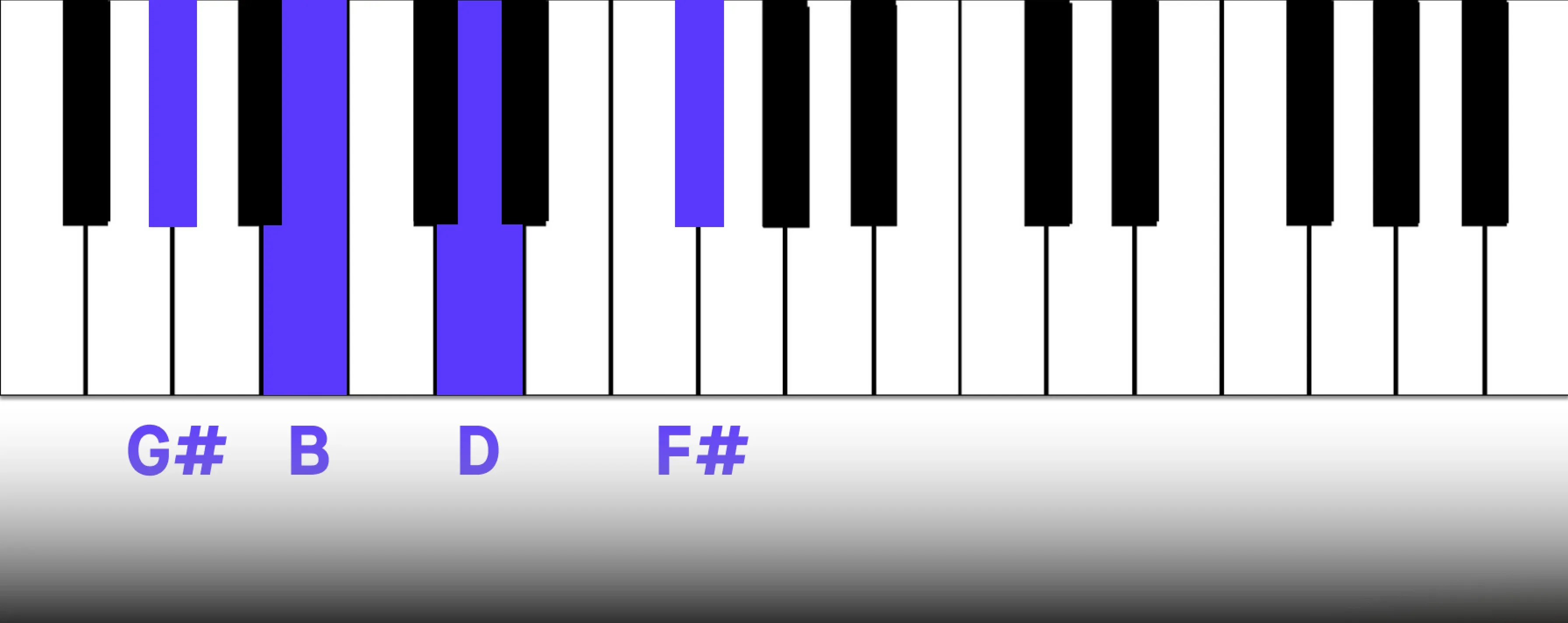
ii° - G#ø7
The G#7b5 chord contains a diminished fifth and introduces a noticeable tension to the harmony. This creates a moment of dramatic suspense in the music. In the supertonic position, it tends to resolve to the dominant or the tonic.
The diminished quality of the G#7b5 adds a strong dissonance to the F sharp minor key. This dissonance increases the emotional intensity of the music. It often leads to a more stable chord, like the dominant or tonic.
The G#ø7 chord differs from the “G#dim7” chord, where the seventh note is also diminished.
III - Amaj7
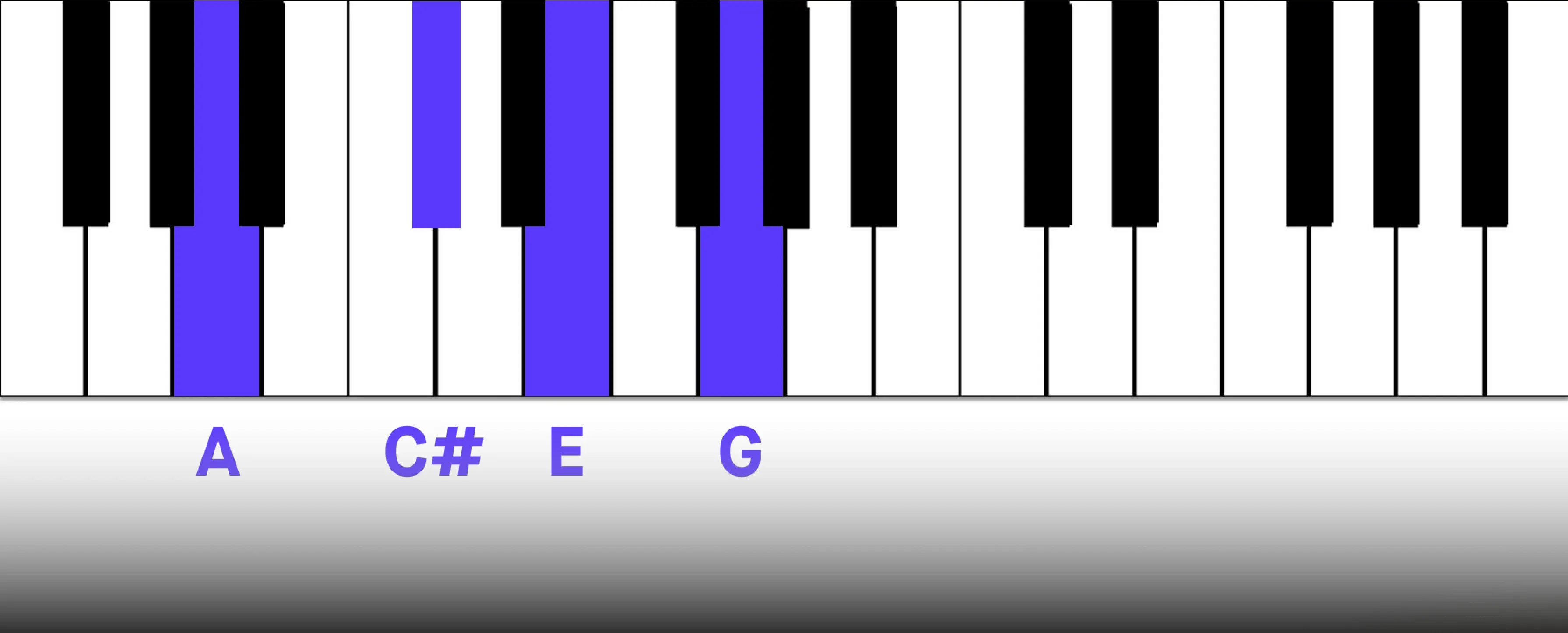
The mediant A Major 7th chord introduces a noticeable contrast in harmonic color, as its major quality stands out against the somber background of the minor key. This contrast serves to create moments of temporary brightness or a contemplative atmosphere, enriching the emotional depth of the musical composition.
Beyond its role in providing harmonic contrast, the mediant chord, in general, is used to introduce harmonic variety. A specific function of the mediant is its use as a tonic substitute.
This means it can provide a temporary sense of resolution, creating a brief moment of stability without the conclusive arrival of the tonic chord. This harmonic device can prolong or delay the final resolution, adding complexity and interest to the musical progression. Therefore, the A major chord contributes not only a unique color but also a specific harmonic function to the F sharp minor key.
iv - Bm7
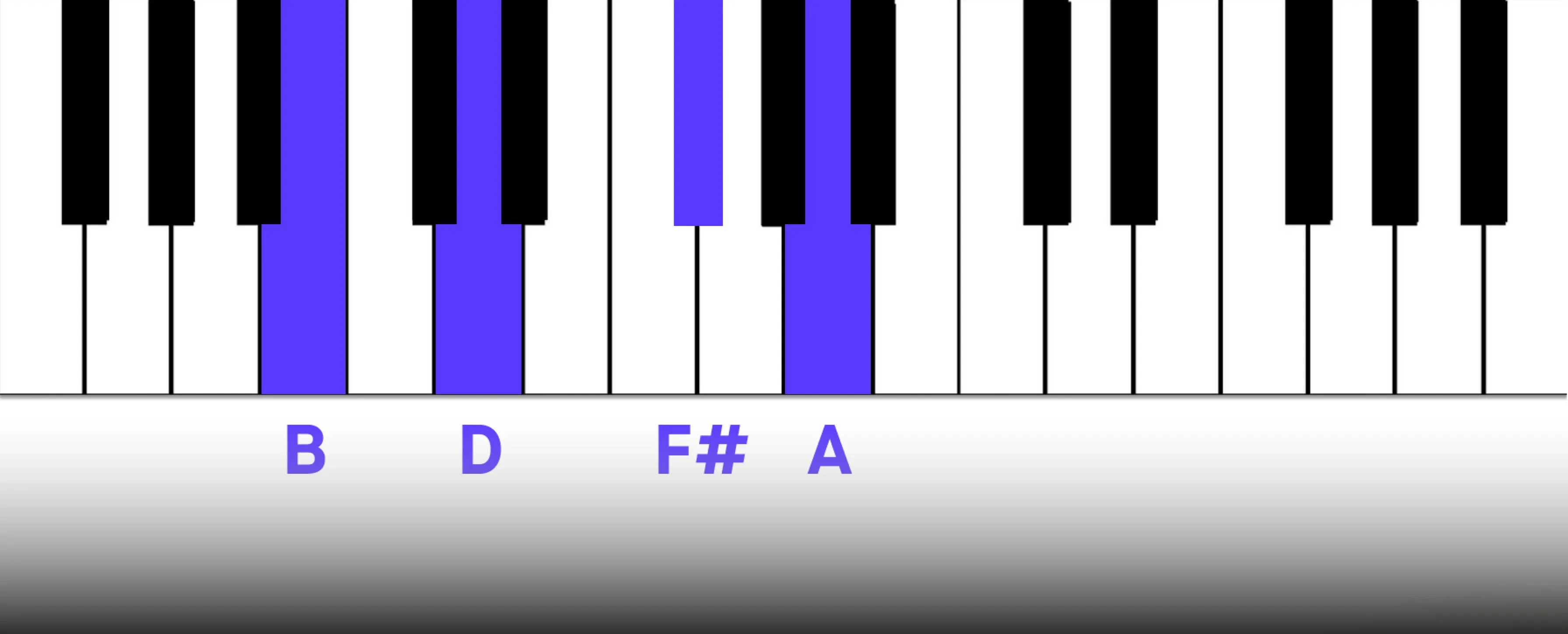
B minor 7 offers a harmonic departure from the tonal center, contributing significantly to harmonic interest and creating a desire for resolution. As a primary chord, the B minor naturally progresses towards either the tonic or the dominant.
The movement from the subdominant to the dominant creates a particularly strong sense of anticipation, heightening the expectation for the subsequent resolution back to the tonic. The iv-v-i progression is a fundamental building block of tonal harmony.
This quality contributes to the inherent function of the subdominant, gently pulling towards the dominant or tonic. The B minor 7 chord plays a crucial role in creating harmonic motion and depth within the F sharp minor key.
v - C#m7
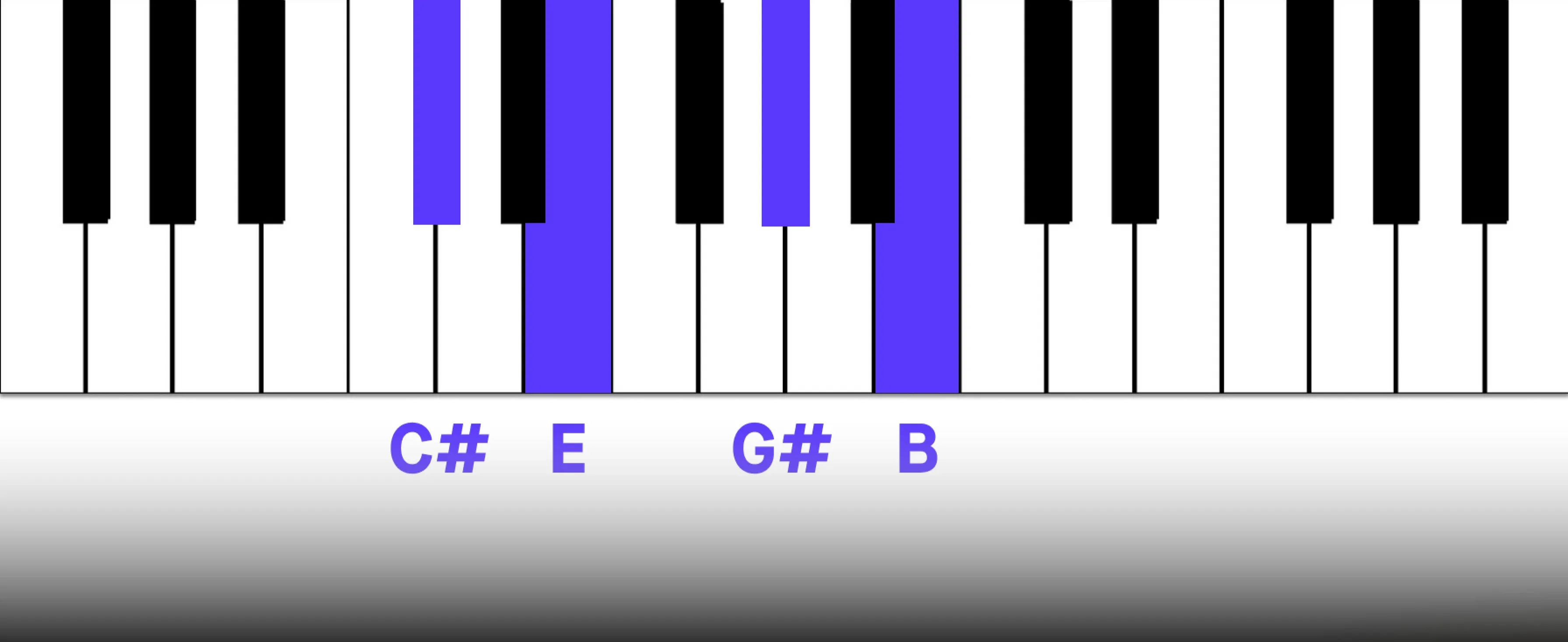
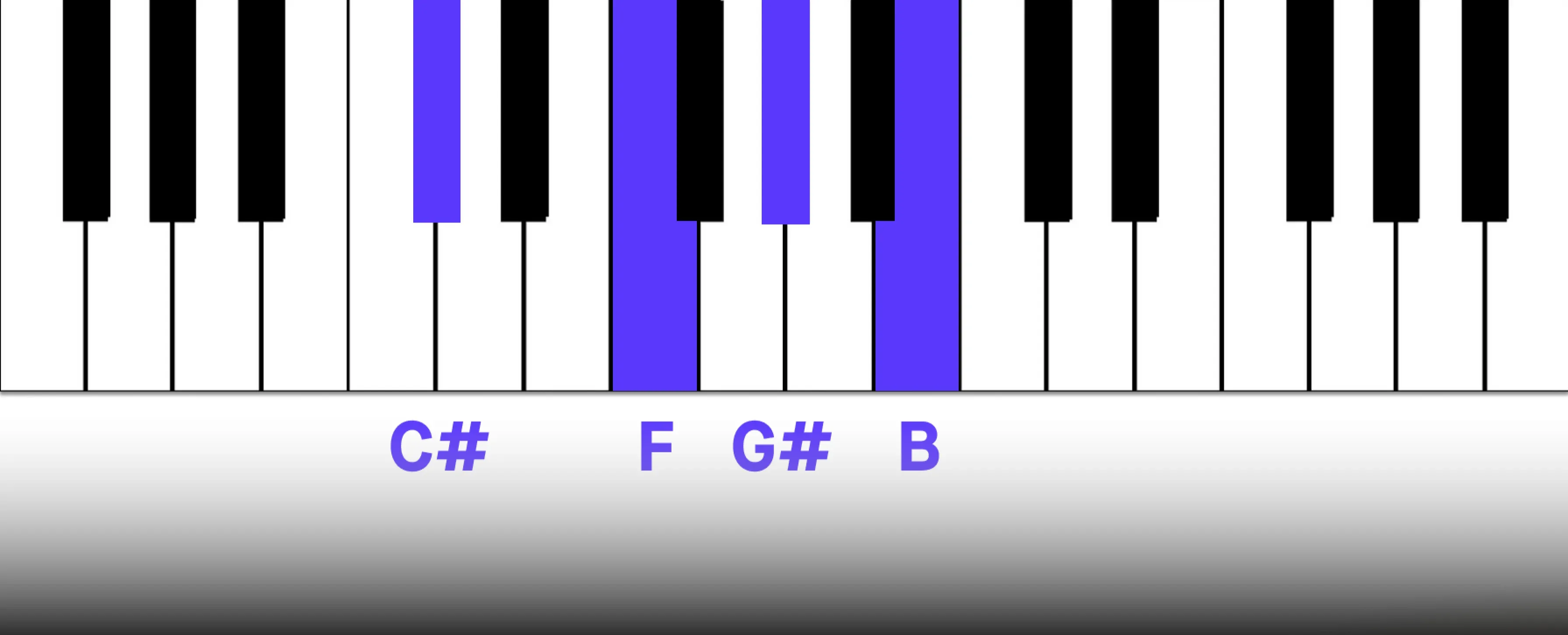
The C#m7 is a primary chord and drives harmonic motion. Its function is to create a strong sense of anticipation and urge resolution back to the tonic.
This dominant function is essential for establishing musical tension and release, shaping the narrative of the music, and providing a sense of harmonic closure.
For the strongest possible cadence, the C#m7 is altered to a dominant 7th chord. The unique character of C#7 arises from its structure: a major triad with an added minor seventh interval. This specific combination produces a dissonance that inherently seeks resolution. This tension is the source of the dominant seventh's strong directional pull. This chord is notably the diatonic dominant seventh chord within a major. But in minor, the third needs to be raised a half-step to create the dominant 7th chord.
The inherent urgency of the C#7 chord for resolution is fundamental to its role. It creates a sense of expectation, a musical question that the tonic chord answers. This pull towards the tonic is what makes the resolution so satisfying, providing a sense of arrival and completion.
VI - Dmaj7
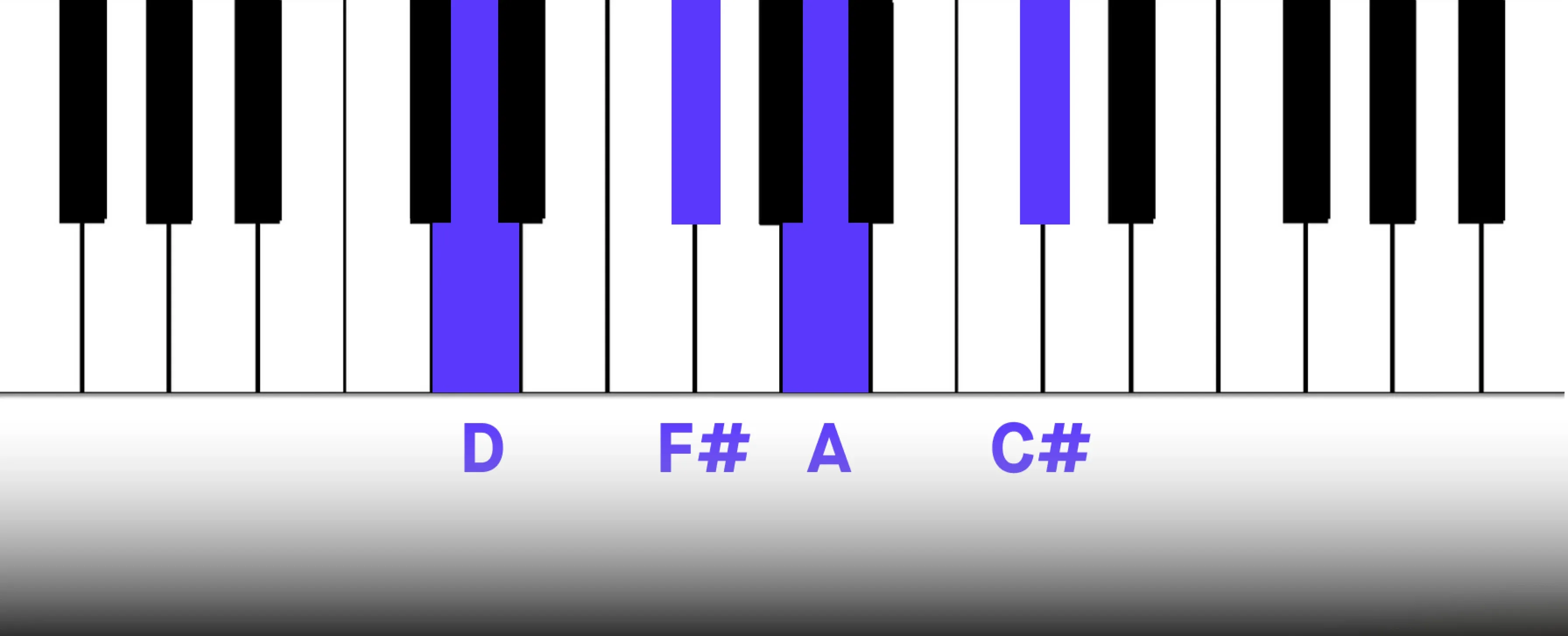
The submediant seventh, D major 7, also introduces a major quality within the minor key. Unlike the supertonic (ii) chords, which possess a strong pull towards the tonic or dominant, the submediant exhibits greater harmonic flexibility, lending a more nuanced emotional quality without a strong sense of directional urgency. For that reason, the submediant is the most commonly used contrasting harmonic color as it enriches the harmonic texture, adding depth and color.
The submediant also plays a significant role in interrupted cadences. In this common harmonic device, the dominant chord creates a strong expectation of resolution to the tonic. However, instead of the expected tonic resolution, the progression moves to the submediant, creating a harmonic surprise and delaying the anticipated closure.
VII - E7
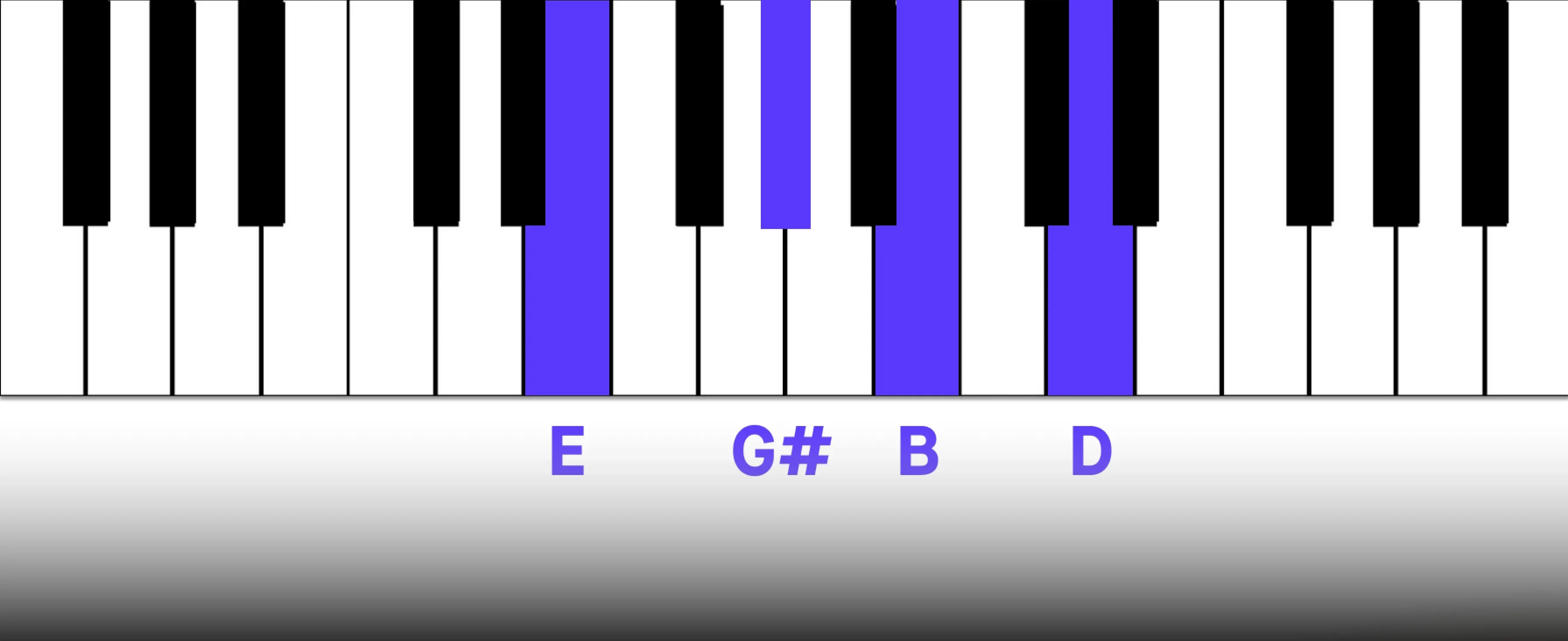
In F sharp minor, the seventh chord built on the seventh scale degree is E7. This chord, a major triad with a minor seventh, is often referred to as the subtonic seventh. While its construction mirrors that of a dominant seventh (V7), its harmonic function differs significantly. Unlike the dominant seventh, which creates a strong, directional pull towards the tonic, the E7 exhibits a less intense, more nuanced harmonic pull.
The dominant seventh's (V7) compelling resolution to the tonic (i) is largely due to the leading-tone relationship: the third of the V7 chord is a half-step below the tonic's root. The E7, lacking this leading-tone relationship, does not generate the same level of harmonic tension.
Instead, the E7 chord in F sharp minor provides harmonic flexibility. It can resolve to a wider range of chords within the key, offering a less predictable and more varied harmonic pathway. This characteristic allows for greater harmonic exploration and can contribute to a more subtle and nuanced emotional expression than the more direct V7-i resolution.
Learn how to put all these chords together in intriguing chord progressions by reading our article “A Comprehensive Guide to Crafting Chord Progressions in F sharp minor”.
Different Types of Seventh Chords
Minor Seventh Chord
- Formula: Root - Minor 3rd - Perfect 5th - Minor 7th
- Notation: m7, min7, -7
- Diatonic Scale Degree in F sharp minor: Tonic (i), Subdominant (iv), Dominant (v)
- Sound & Function: The minor seventh chord's sound is characterized by a warm, smooth feel, often evoking introspection and melancholy. This expressive quality makes it useful for conveying subtle sadness or contemplative moods. Within a minor key, the tonic triad naturally evolves into a minor seventh chord, significantly enriching its harmonic depth and adding a distinct tonal color. Strategically alternating between the simple minor triad and its seventh chord counterpart introduces subtle nuance and captivating variety to a musical composition. Its mellow tone is especially effective for creating feelings of gentle sorrow, reflection, or quiet longing.
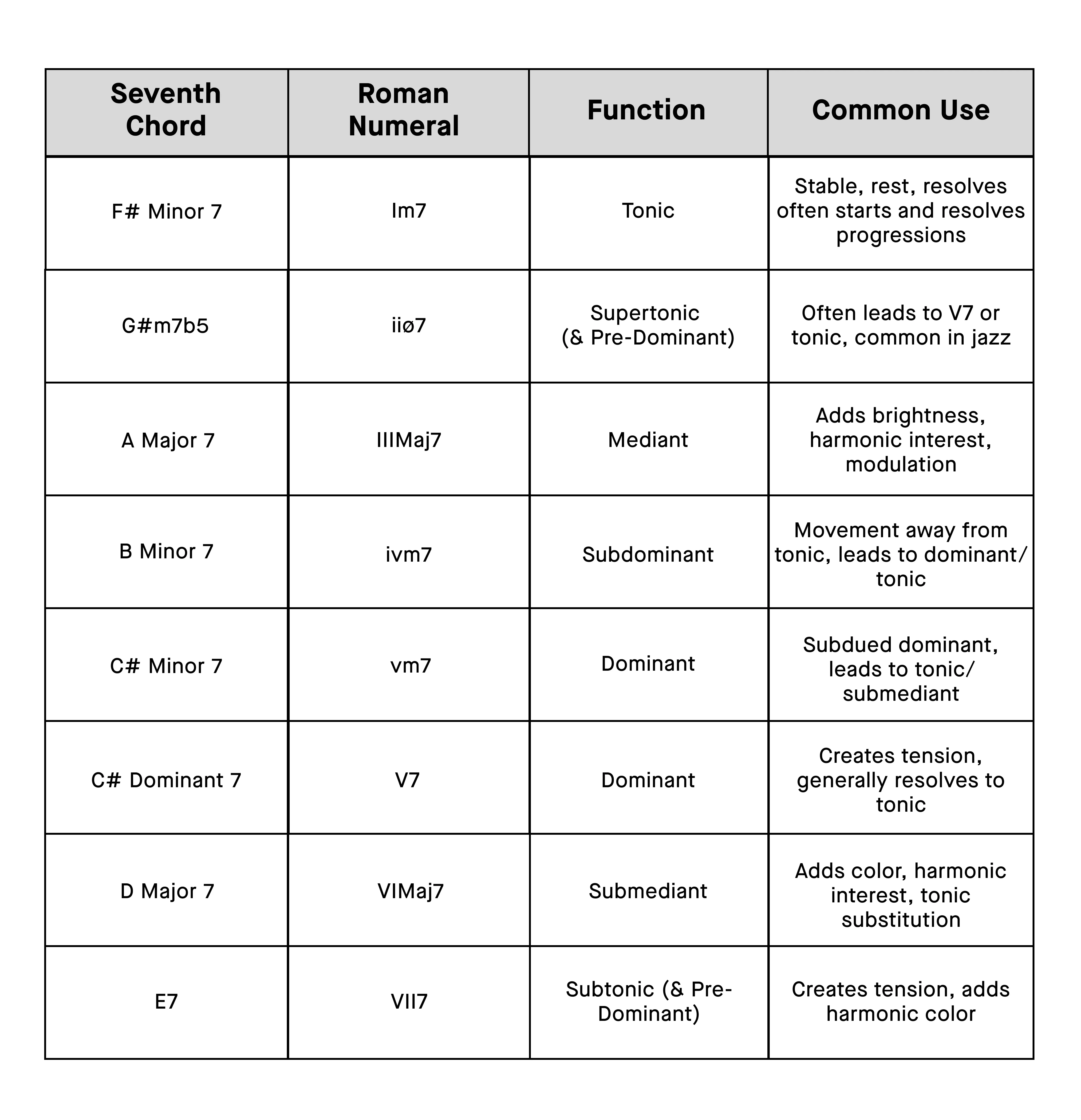
Major Seventh Chord
- Formula: Root - Major 3rd - Perfect 5th - Major 7th
- Notation: maj7, M7, △7, △
- Diatonic scale degree F sharp minor: Mediant (III), Submediant (VI)
- Sound & Function: The major seventh chord's sophisticated and subtly rich sound enhances harmonic textures, making it a versatile tool applicable to various musical styles and genres. Built by adding a major seventh to a major triad, this chord achieves a blend of stability and gentle, slightly longing character. The major seventh chord enhances the harmonic richness with warmth and complexity, adding to the sonic texture.
Dominant Seventh Chord
- Formula: Root - Major 3rd - Perfect 5th - Minor 7th
- Notation: V7
- Diatonic scale degree in F sharp minor: Subtonic (VII)
- Sound & Function: The dominant seventh chord is crucial for harmonic tension. The V7-I interval, known as a perfect cadence, is a cornerstone in Western harmony tradition. The unique sound of the dominant 7th chord comes from the major triad with a minor 7th added on top. In a major scale, the dominant seventh occurs diatonically on the fifth scale degree. However, in a minor scale, we first need to alter the minor dominant chord to a major one - then add the minor 7th. Instead, the dominant 7th chord occurs naturally on the subtonic scale degree (VII) in a minor natural scale. The blues genre further showcases the dominant seventh's versatility by applying it to chords other than the dominant, such as the tonic and subdominant, which helps to create the genre's signature tension and release.
Half Diminished Seventh Chord
- Formula: Root - Minor 3rd - Diminished 5th - Minor 7th
- Notation: ø7, m7b5
- Diatonic Scale Degree in F sharp minor: Supertonic (ii)
- Sound & Function: The half-diminished seventh chord (ø7 or m7b5) has a somber and dissonant characteristic and is common in jazz, blues, and funk. It deepens harmonic sequences with richness and intricacy. Its natural unease comes from the tritone between the root and lowered fifth, creating a strong desire to resolve to a more stable and harmonious chord.
Diminished Seventh Chord
- Formula: Root - Minor 3rd - Diminished 5th - Diminished 7th
- Notation: °7, dim7 Scale Degree in F sharp minor: (None)
- Sound & Function: The diminished seventh chord stands out with its intense and unstable sound, which comes from its unique and symmetrical structure: four minor thirds layered on top of one another. This balanced design gives the diminished seventh chord an interesting trait: a small change to only one note can change it into multiple distinct dominant seventh chords. For instance, F#dim7's inherent versatility allows it to transform into four distinct dominant 7th chords. Lowering each chord tone by a half-step yields F7, Ab7, B7, and D7, respectively. This harmonic flexibility enables seamless modulations and creates compelling secondary dominant progressions with a unique tonal character.
Minor Major Seventh Chords
- Formula: Root - Minor 3rd - Perfect 5th - Major 7th
- Notation: mMaj7, Minmaj7, mM7
- Diatonic Scale Degree in F sharp minor: (none)
- Sound & Function: As it's not part of F sharp minor's diatonic harmonies, the minor-major seventh chord is a less frequent occurrence. It's primarily encountered within a "line cliché," a musical figure where a minor chord is held while another voice, often bass or soprano, moves chromatically, resulting in the chord's distinctive sound.
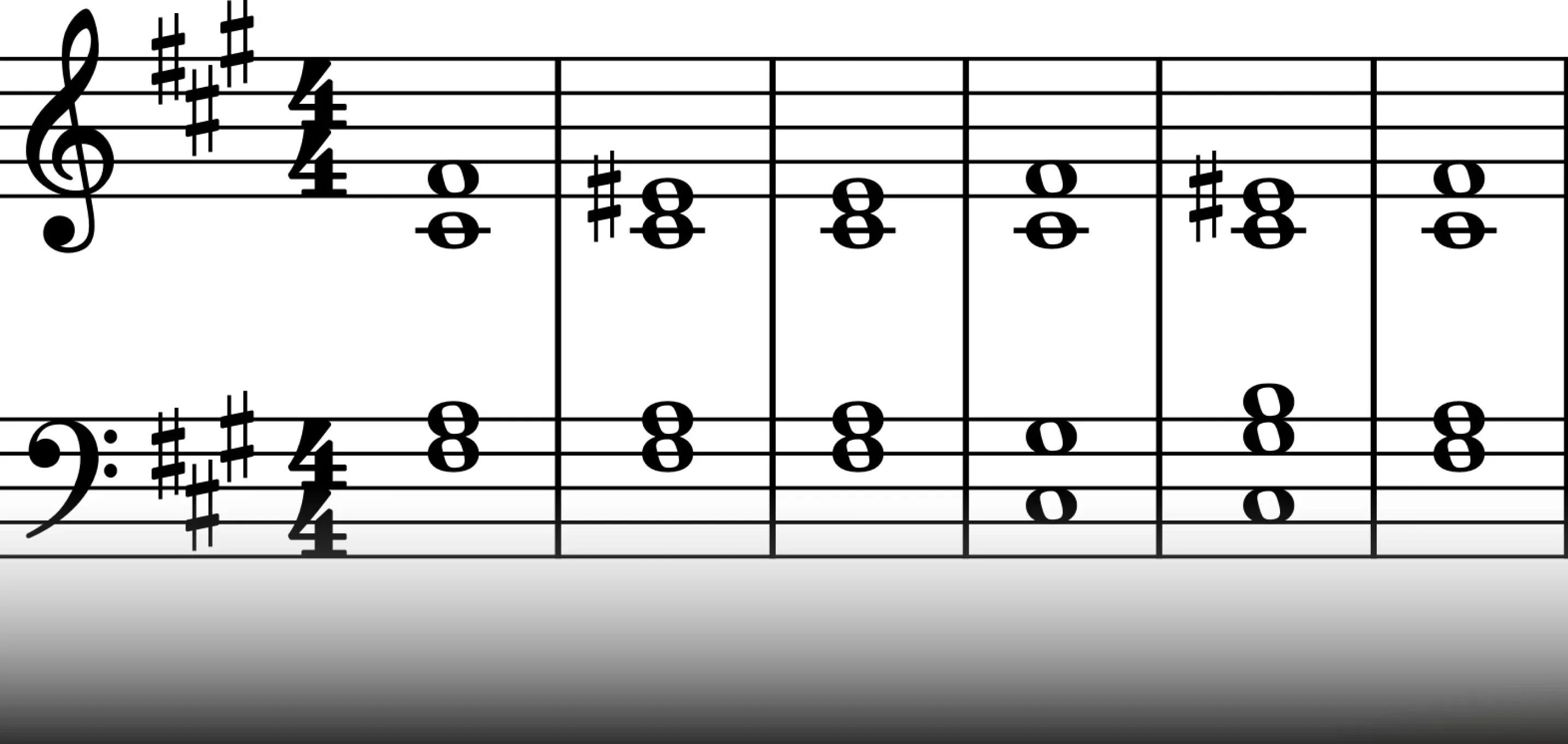
Modified Seventh Chords
To expand your harmonic palette, use suspended and augmented seventh chords, which offer diverse colors and textures, enabling a wider range of expression and the creation of subtle tension in your music.
Suspended Seventh Chords
- Formula Sus4: Root - Perfect 4th - Perfect 5th - Minor 7th
- Formula Sus2: Root - Major 2nd - Perfect 5th - Minor 7th
- Notation: 7sus4. 7sus2 The inherent instability of both seventh and suspended chords is amplified when combined, resulting in chords that create a strong sense of anticipation and forward momentum. This heightened tension makes them exceptionally effective as passing chords, adding vibrant color and dynamism to harmonic progressions. They also excel at harmonizing ascending or descending bass lines, driving both melodic and harmonic movements. A good example is ABBA's "" where a ii7sus4 chord lends a distinctive and memorable harmonic flavor.
Maj7♯5 (Augmented Seventh Chord)
- Formula Sus4: Root - Major 3rd - Augmented 5th - Minor 7th
- Notation: maj7#5, Aug+7
The augmented major seventh chord, built from an augmented triad and a major seventh, creates a compelling harmonic tension. When used on the dominant degree, its augmented fifth acts as a strong leading tone, resolving chromatically upwards to the tonic's major third, providing a powerful sense of arrival. To avoid confusion,"maj7♯5"is the preferred notation, as "augmented seventh" can be ambiguous. To enhance your understanding of chord qualities, focus on interval recognition. Our ear training and interval study guide, complete with song examples for all ascending and descending intervals, will help you internalize these crucial harmonic building blocks. Recognizing intervals is crucial for understanding chord qualities. Our ear training and interval study guide, with its helpful song examples for all intervals, will aid you in internalizing these essential components of harmony.
Chord Progressions Using Seventh Chords in F Sharp Minor
i (F#m) - V7 (C#7) - i (F#m) - VI (D) - III (A)
Paul McCartney's "Junk" exemplifies a straightforward chord progression that effectively utilizes the dominant-tonic relationship. The song features a clear progression from the tonic to the dominant, followed by the expected resolution back to the tonic. Notably, the subsequent section begins with a sustained A major chord, functioning as a tonic substitute. This substitution creates a moment of harmonic ambiguity, delaying the definitive return to the tonic and adding harmonic interest.
i (F#m) - V7 (C#7) - i (f#m) - IV7 (B7) - VI7 (Dmaj)
This chord sequence also employs the fundamental tonic-dominant relationship but introduces a significant harmonic alteration for added interest. Instead of the diatonic Bm7 chord, the progression features a borrowed parallel subdominant. This alteration involves both a raised third, transforming the chord to major, and the addition of a dominant seventh, replacing the major seventh. This chromatic alteration creates a striking shift in the harmony, adding depth and complexity to the progression, and maintaining listener engagement. We hear this chord progression in “Put Your Records On” by Corinne Bailey Rae.
i (F#m) - III (A) - i (F#m7/C#) - iv7 (Bm7)
This is the progression from “Bloodstream” by Stateless and it effectively illustrates how a single chord can be employed multiple times while maintaining harmonic variety and interest. While previous examples showcased a standard tonic-dominant-tonic (i-V-i) progression, this sequence introduces variation in the second tonic occurrence. The tonic chord is presented as a seventh chord in an inverted position, which reduces its harmonic stability and adds a layer of harmonic depth. This is followed by a Bm7 chord, which then leads into a IV-i plagal cadence, creating a distinct harmonic resolution.
i (F#m) - v7 (C#m7) - VI (Dmaj7) - i (F#m) - v7 (C#m7) - iv7 (Bm7) - v (C#m)
The chorus of Naughty Boy's "La La La" uses a chord progression that utilizes the minor seventh chord on the dominant scale degree. This choice creates a less tense and conclusive harmonic environment compared to the standard dominant seventh chord. This reduced tension contributes to a smoother progression, minimizing the need for immediate resolution and establishing clearer phrase boundaries. Furthermore, the progression alternates between Dmaj7 and Bm7 as the third chord in each repetition, effectively introducing harmonic variety within a relatively consistent chord structure.
VI (D) - III (A) - iv7 (Bm7) - i (F#m)
The solo section of Death Cab For Cutie’s “Title and Registration” employs a chord progression that begins with the submediant, functioning as a tonic substitute. This initial substitution creates a sense of harmonic ambiguity. The progression then moves to A major, a chord closely related to the tonic through shared tones, further contributing to the harmonic ambiguity. The introduction of a minor subdominant seventh chord provides a contrasting minor quality, which ultimately resolves to the tonic, establishing a sense of stability and resolution. The avoidance of primary chords in the initial portion of the progression effectively builds anticipation and harmonic tension.
VI7 (Dmaj7) - VII (E) - i7 (F#m7) - VII7 (E7)
In the pre-chorus of Lady Gaga’s "Do What You Want", the harmonic structure employs a tonic substitute and a dominant seventh chord built on the seventh scale degree. The D major chord, serving as a temporary tonic, creates a distinct contrast, clearly differentiating this section from the preceding and subsequent, more harmonically stable sections. The true tonic chord appears briefly, functioning more as a passing chord or a transitional element, primarily serving to establish harmonic movement before the introduction of the tension-filled dominant seventh chord. This strategic use of harmonic instability in the pre-chorus heightens the anticipation for the more grounded sections that follow.
How to Practice Seventh Chords
Begin exploring seventh chords in F sharp minor by mastering their root positions. This builds a solid foundation and familiarizes you with their four-note structure. Pay close attention to voice leading for smooth chord changes. To fully understand each chord's sound, practice arpeggios, playing each note separately. This helps reveal melodic potential and is a common technique in fingerstyle guitar and similar styles. The following exercises will help you develop fluid chord transitions:
- Diatonic Seventh Chord Progressions: Start your practice with basic progressions using the seventh chords found within F sharp minor, like F#7 - Bm7 - Dmaj7 - C#7. Emphasize smooth chord changes through effective voice leading, and explore different rhythmic patterns and tempos to add variety.
- Two-Chord Transition Drills: Practice transitioning between every combination of seventh chords and triads within F sharp minor. This will build strong muscle memory for common voice-leading techniques and deepen your understanding of the intervals created during these chord changes.
- Seventh Chord Inversion Exercises: Work through each seventh chord found in F sharp minor, playing them in all four inversions. This will help you learn the various voicings and how each inversion changes the chord's sound. Pay close attention to the bass line movement that results from each inversion.
If you don’t play piano, guitar, or any other chordal instrument, create different chord progressions in your DAW using seventh chord and be mindful of the transition between each chord and their inherent qualities.
Real-Time Collaboration with Professional Musicians
Collaborate and record your music with professional artists and elevate your songs to the next level. With the Unlimited membership, your music potential is limitless. Get instant access to unlimited recording sessions and a roster of 90+ professional musicians, songwriters, and engineers.
Bring Your Songs to Life: Hire session musicians and breathe life into your music. By joining each session via live link you can work with session drummers, string players, beat makers, bassists, guitarists, vocalists, and much more, to make sure your musical vision is realized. Schedule each session at a time that’s convenient for you, join live, and experience the joy of witnessing your music coming to life.
Songwriting Support from Start to Finish: If you have an idea or a seed for a song, you can book a songwriting session. They’ll help you with melodic development, harmony, lyrics, and everything else that goes into the process of writing a song.
Polish Your Tracks for Release: To ensure your music is ready for release, get your music professionally mixed and mastered by our award-winning engineers. To ensure the music reaches the right audience, book a session with our marketing experts and create a detailed plan for a successful launch.
Musiversal Blog: Your Music Resource The Musiversal blog is updated weekly and offers expert insights on music theory, songwriting, production, gear, music marketing, and more.
Your Music, No Limits.
Join the Waitlist